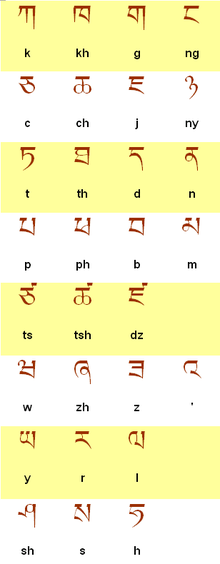Inscription after Wylie
The Wylie transcription is a method of transcribing (more precisely: transliteration ) the Tibetan script , in which only the characters on a normal English keyboard (i.e. without umlauts and special characters) are used. This method is named after Turrell Wylie , who published this transcription in 1959 after slightly improving existing systems. Since the original text can be reconstructed in Tibetan script from the legend according to Wylie, there is also an important feature of transliteration. The Wylie romanization became the standard romanization of Tibetan in the United States and is used in Tibetology worldwide.
Consonants
In the Wylie transcription, the consonants are rendered as follows:
| ཀ k | ཁ kh | ག g | ང ng |
| ཅ c | ཆ ch | ཇ j | ཉ ny |
| ཏ t | ཐ th | ད d | ན n |
| པ p | ཕ ph | བ b | མ m |
| ཙ ts | ཚ tsh | ཛ dz | |
| ཝ w | ཞ zh | ཟ z | འ ' |
| ཡ y | ར r | ལ l | |
| ཤ sh | ས s | ཧ h |
The last letter of the Tibetan alphabet ཨ , the "zero consonant", is not reproduced because it is represented by a syllable with an initial vowel.
The consonant clusters of the Tibetan script are represented either by preceding or following letters or by superscript or subscript. The Wylie transliteration does not differentiate between these, since in practice no ambiguities can arise due to the Tibetan spelling. The only exception to this is the sequence of letters gy-, which can be written either by a g preceding the y or a subscript y. In the Wylie romanization , these spellings are differentiated in that the preceding g is followed by a period ( gy- ), but not with a subscript y ( gy- ), e.g. B. གྱང gyang (wall), གཡང་ g.yang (abyss).
Vowels
The four vowel marks are represented as follows:
| ཨི i | ཨུ u | ཨེ e | ཨོ o |
(Note: The vowel signs are above (e, i, o) or below (u) the consonant. If they appear to be shifted to the right here, this is a technical failure of the installed font or the browser.)
If a syllable has no vowel mark , the letter a is inserted to indicate the inherent vowel a (e.g. ཨ་ = a).
Capitalization
In earlier Tibetan romanization systems, capital letters were used to identify the root letters. Words could be looked up in the lexicon after these root letters. However, this method was not applied consistently. Therefore, when transcribing according to Wylie, only the first letter of a word is written in capital letters. The Buddhist school Kagyu is therefore represented as Bka 'rgyud and not as bKa' rgyud .
Further development: Extended Wylie
Fukuda Yōichi ( 福田 洋 一 ) describes an expanded version of the Wylie transcription. Thereby u. a. Use capital letters for the transliteration of the retroflex consonants Ta, THa, Da, Na and SHa that occur in Sanskrit words (in Tibetan these are called log yig ) as well as for the rendering of the anusvara (final, nasal "M"). Nathaniel Garson and David Germano published an even more detailed system.
See also
Web links
- Staatsbibliothek Berlin - A standard system of Tibetan transcription
- Turrell Wylie: A Standard System of Tibetan Transcription. Harvard Journal of Asiatic Studies . ( Memento of December 4, 2006 in the Internet Archive ) 195, pp. 261-267
- Wylie table. Nitartha International
- Nathaniel Garson, David Germano: Extended Wylie Transliteration Scheme . (PDF)
- Online transliterator (generates graphics, UNICODE or other transliteration from Wylie or ACIP -transliteration or UNICODE)
Individual evidence
- ^ Turrell Wylie: A Standard System of Tibetan Transcription . In: Harvard Journal of Asiatic Studies , vol. XXII, 1959, pp. 261-267
- ^ Fukuda Yoichi: Extended Wylie Method of the Transcription of Tibetan Characters and the Database Project of Asian Languages: Toyo Bunko . In: Helmut Krasser et al. (editors): Tibetan Studies Proceedings of the 7th Seminar of the International Association of Tibetan Studies, Graz 1995 , vol. I. Verlag of the Austrian Academy of Sciences, Vienna 1997, pp. 293–297. see. Yoichi Fukuda: Extended Wylie Method of the transcription of Tibetan characters . ( Memento of February 10, 2003 in the Internet Archive ), Tōyō Bunko .
